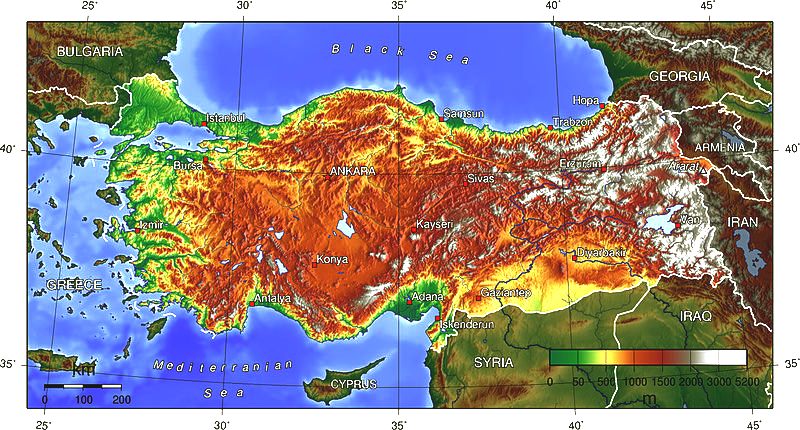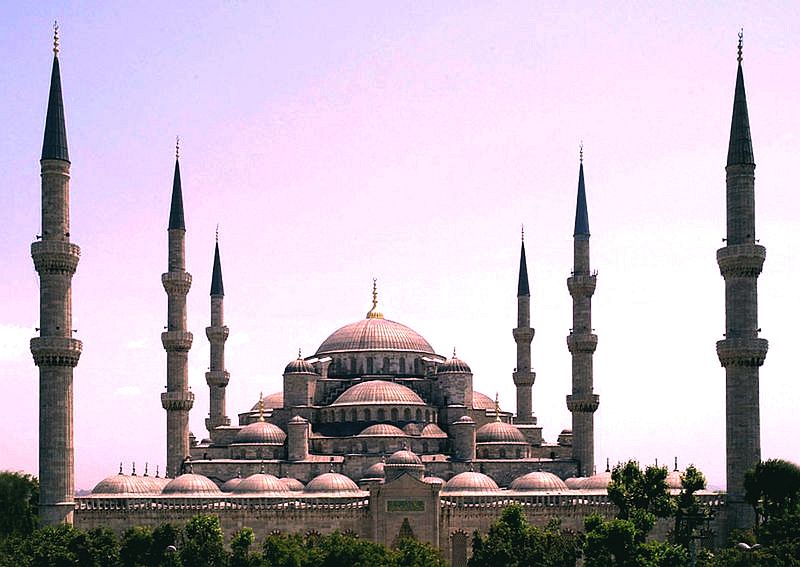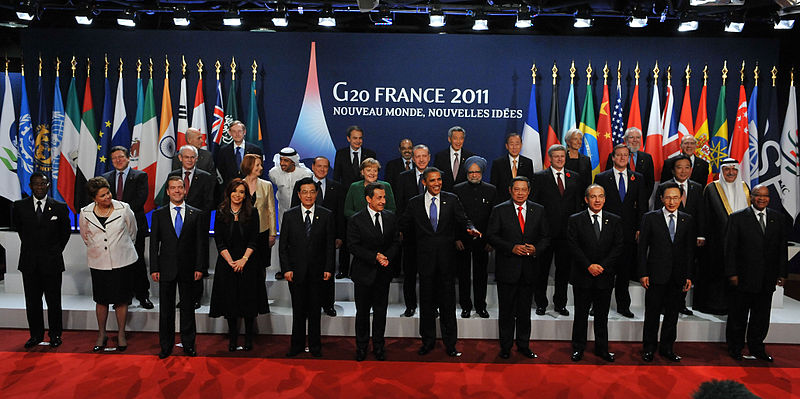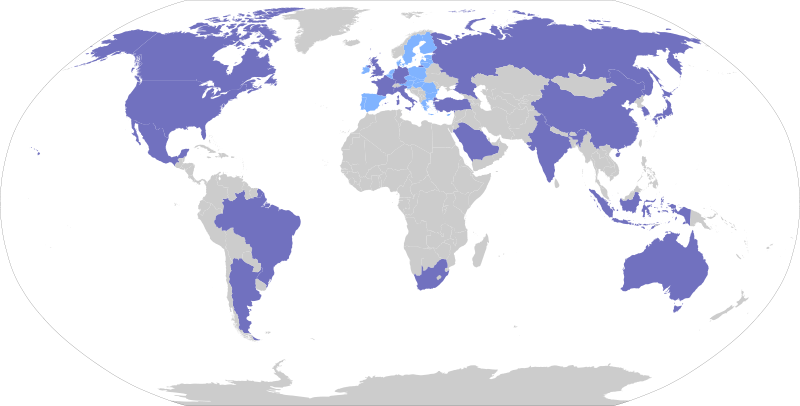|
The
World Electric Navigation Challenge
1.
G8/G20 SUMMITS
TURKEY
The
territory of Turkey is more than 1,600 kilometres (1,000 mi) long and 800 km
(500 mi) wide, with a roughly rectangular shape. It lies between latitudes
35° and 43° N, and longitudes 25° and 45° E. Turkey's area, including
lakes, occupies 783,562 square kilometres (300,948 sq mi), of which 755,688
square kilometres (291,773 sq mi) are in Southwest Asia and 23,764 square
kilometres (9,174 sq mi) in Europe. Turkey is the world's 37th-largest
country in terms of area. The country is encircled by seas on three sides:
the Aegean Sea to the west, the Black Sea to the north and the Mediterranean
to the south. Turkey also contains the Sea of Marmara in the northwest.

Istanbul and the Bosphorus
The European section of Turkey, East Thrace, forms the borders of Turkey with
Greece and Bulgaria. The Asian part of the country, Anatolia, consists of a high
central plateau with narrow coastal plains, between the Köroğlu and Pontic
mountain ranges to the north and the Taurus Mountains to the south. Eastern
Turkey has a more mountainous landscape and is home to the sources of rivers
such as the Euphrates, Tigris and Aras, and contains Mount Ararat, Turkey's
highest point at 5,137 metres (16,854 ft), and Lake Van, the largest lake in the
country.
Turkey is divided into seven census regions: Marmara, Aegean, Black Sea, Central
Anatolia, Eastern Anatolia, Southeastern Anatolia and the Mediterranean. The
uneven north Anatolian terrain running along the Black Sea resembles a long,
narrow belt. This region comprises approximately one-sixth of Turkey's total
land area. As a general trend, the inland Anatolian plateau becomes increasingly
rugged as it progresses eastward.
Turkey's varied landscapes are the product of complex earth movements that have
shaped the region over thousands of years and still manifest themselves in
fairly frequent earthquakes and occasional volcanic eruptions. The Bosphorus and
the Dardanelles owe their existence to the fault lines running through Turkey
that led to the creation of the Black Sea. There is an earthquake fault line
across the north of the country from west to east, which caused a major
earthquake in 1999.

Climate
The coastal areas of Turkey bordering the Aegean Sea and the Mediterranean Sea
have a temperate Mediterranean climate, with hot, dry summers and mild to cool,
wet winters. The coastal areas of Turkey bordering the Black Sea have a
temperate Oceanic climate with warm, wet summers and cool to cold, wet winters.
The Turkish Black Sea coast receives the greatest amount of precipitation and is
the only region of Turkey that receives high precipitation throughout the year.
The eastern part of that coast averages 2,500 millimetres annually which is the
highest precipitation in the country.
The coastal areas of Turkey bordering the Sea of Marmara (including Istanbul),
which connects the Aegean Sea and the Black Sea, have a transitional climate
between a temperate Mediterranean climate and a temperate Oceanic climate with
warm to hot, moderately dry summers and cool to cold, wet winters. Snow does
occur on the coastal areas of the Sea of Marmara and the Black Sea almost every
winter, but it usually lies no more than a few days. Snow on the other hand is
rare in the coastal areas of the Aegean Sea and very rare in the coastal areas
of the Mediterranean Sea.
Conditions can be much harsher in the more arid interior. Mountains close to the
coast prevent Mediterranean influences from extending inland, giving the central
Anatolian plateau of the interior of Turkey a continental climate with sharply
contrasting seasons.
G20
HISTORY
The Group of Twenty Finance Ministers and Central Bank Governors (also known as the G-20, G20, and Group of Twenty) is a group of finance ministers and central bank governors from 20 major economies: 19 countries plus the
European Union, which is represented by the President of the European Council and by the European Central
Bank. The G-20 heads of government or heads of state have also periodically conferred at summits since their initial meeting in 2008. Collectively, the G-20 economies account for more than 80 percent of the gross world product
(GWP), 80 percent of world trade (including EU intra-trade), and two-thirds of the world
population. They furthermore account for 84.1 percent and 82.2 percent of the world's economic growth by nominal GDP and GDP (PPP) respectively from the years 2010 to 2016, according to the
International Monetary Fund
(IMF).
The G-20 was proposed by former Canadian Prime Minister Paul
Martin as a forum for cooperation and consultation on matters pertaining to the international financial system. The group was formally inaugurated in September 1999, and held its first meeting in December 1999. It studies, reviews, and promotes high-level discussion of policy issues pertaining to the promotion of international financial stability, and seeks to address issues that go beyond the responsibilities of any one organization. With the G-20 growing in stature after the 2008
Washington summit, its leaders announced on September 25, 2009, that the group would replace the
G8 as the main economic council of wealthy
nations.
The heads of the G-20 nations met biannually at G-20 summits between 2008 and 2011. Since the November 2011 Cannes summit, all G-20 summits have been held
annually.

2011 G-20
France, Cannes summit group photo.
The G-20, which superseded the G33 (which had itself superseded the G22), was foreshadowed at the Cologne Summit of the G7 in June 1999, but was only formally established at the G7 Finance Ministers' meeting on 26 September 1999. The inaugural meeting took place on 15–16 December 1999 in
Berlin. In 2008, Spain and the
Netherlands were included, by French invitation, in the G-20 Leaders Summit on Financial Markets and the World Economy.
The theme of the 2006 G-20 meeting was “Building and Sustaining Prosperity”. The issues discussed included domestic reforms to achieve “sustained growth”, global energy and resource commodity markets, ‘reform’ of the World Bank and IMF, and the impact of demographic changes due to an aging population. Trevor A. Manuel, MP, Minister of Finance, South Africa, was the chairperson of the G-20 when
South Africa hosted the Secretariat in 2007. Guido Mantega, Minister of Finance,
Brazil, was the chairperson of the G-20 in 2008; Brazil proposed dialogue on competition in financial markets, clean energy and economic development and fiscal elements of growth and development. In a statement following a meeting of G7 finance ministers on 11 October 2008, US President
George W. Bush stated that the next meeting of the G-20 would be important in finding solutions to the burgeoning economic crisis of 2008. An initiative by
French President Nicolas Sarkozy and British Prime Minister
Gordon Brown led to a special meeting of the G-20, a G-20 Leaders Summit on Financial Markets and the World Economy, on 15 November
2008.
Despite lacking any formal ability to enforce rules, the G-20's prominent membership gives it a strong input on global policy. However, there remain disputes over the legitimacy of the
G-20, and criticisms of its organisation and the efficacy of its
declarations.
Summits
The G-20 Summit was created as a response both to the financial crisis of 2007–2010 and to a growing recognition that key emerging countries were not adequately included in the core of global economic discussion and governance. The G-20 Summits of heads of state or government were held in addition to the G-20 Meetings of Finance Ministers and Central Bank Governors, who continued to meet to prepare the leaders' summit and implement their decisions. After the debut summit in Washington, D.C. during 2008, G-20 leaders met twice a year in
London and Pittsburgh in 2009,
Toronto and Seoul in
2010.
Since 2011, when France chaired and hosted the G-20, the summits have been held only once a
year. Mexico chaired and hosted the leaders' summit in 2012. Future summits will be held in
Russia in 2013, Australia in 2014 and
Turkey in 2015.

ECO
TOUR
EVENTS 2015
1.
G8 G20 Summit Turkey, June 2015
2.
Thames Festival England, Sept
2015
3.
WWEC World Wind and Energy
Conference and Exhibition Argentina, October 2015
4.
Solar Energy Asia Singapore,
November 2015
5.
GreenXchange USA, December
2015

Project
Objectives
Galley
| Paints | Screens | Diving
Project
Estimates | Record Attempt | PR Events
Batteries
| Alloys | Timber | Composites | Navigation | Hydraulics
Motors
| Electronics | Solar
Panels | Propeller | Transmission | Tooling | Life Support
Tank
Testing (Model
Construction)& Results

|





